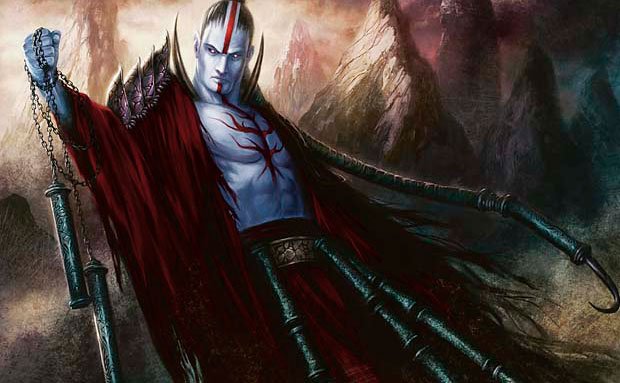Are you a Quiet Speculation member?
If not, now is a perfect time to join up! Our powerful tools, breaking-news analysis, and exclusive Discord channel will make sure you stay up to date and ahead of the curve.
As January comes to a close, it's time to start looking forward to the new Modern. Kaldheim hits shelves next Friday, and while its impact on Modern will be muted, there will be new brews and deck adjustments which will cause some turbulence. The only question is whether there will be a major change, either from a major deck retool or something new emerging. I'm skeptical of the latter, but Modern's cardpool is far too deep to be certain. At least there's no Oko or Uro this time!
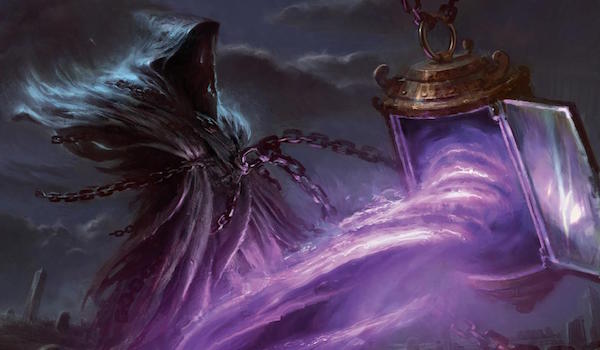
Thus we're in that weird period between the death of the old normal and the birth of the new. Next week's update will close the book on that metagame, but until then, we might as well explore the current one. Fortunately, Wizards gave me the perfect opportunity to do exactly that.
Last week was Super Qualifier week on MTGO. These are PTQ level tournaments that award two invites to... whatever they call the Arena version of... Players Tours? (Is that what they're called now? I've lost track.) Anyway, normally this would only mean that my data is going to get a huge boost from a very competitive event. However, for unknown reasons, this round included All-Access passes. Normally associated with Eternal Weekend, the passes are exactly what they sound like, granting access to every non-promo card on MTGO. Meaning you can play whatever deck you actually want for the duration of the pass. Naturally, I scooped one up and went on an MTGO bender. And today I'm sharing what I learned.
Getting a League Up
My All-Access play was centered on Leagues, as my schedule doesn't sync with the rather odd scheduling of preliminaries and challenges. Early morning or late night I understand; it's a global game, and all world citizens should get a chance. Starting in the middle of the afternoon, though? That's just weird! With Leagues, I can squeeze in matches throughout my work day, which is perfect for my odd downtimes. It also gave me the flexibility to explore multiple decks and formats. Understandably, I played more competitive Magic the past week than over the entirety of the pandemic. It's been a long 11 months and 11 days since my last big tournament (local Modern $1K), and I really needed to shake off the rust. And Leagues are great for that.
Naturally, All-Access meant that I also played a wide variety of decks. That's just getting your money's worth. I didn't test every deck, obviously, and in Modern particularly I was looking to test towards the Friday Super Qualifier, the only one I could attend. And I did learn a lot about the decks I tried. However, testing also left me with a lot more questions about the MTGO metagame than before. Here's a rundown on the decks I tested, in order of testing.
Hammer Time
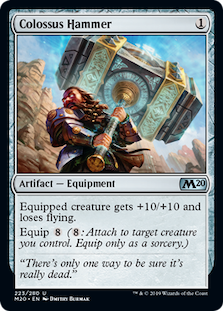 Hammer Time is basically Infect: they have the exact same gameplan. Sometimes, it's literally Infect thanks to Inkmoth Nexus. Unlike Infect, it's actually having metagame impact right now. Also unlike Infect, I'm skeptical that it will maintain much of a presence in Modern. I was underwhelmed by Hammer Time and moved on pretty quickly.
Hammer Time is basically Infect: they have the exact same gameplan. Sometimes, it's literally Infect thanks to Inkmoth Nexus. Unlike Infect, it's actually having metagame impact right now. Also unlike Infect, I'm skeptical that it will maintain much of a presence in Modern. I was underwhelmed by Hammer Time and moved on pretty quickly.
On the one hand, I get why it's getting play. The deck has insane explosive potential. I got my only turn 2 win in competitive Magic ever by dropping Ornithopter and Sigarda's Aid turn one, then two Colossus Hammers against Tron. There's also a very convoluted way to win via Inkmoth on that turn, but it's so unlikely I discount it. There are a lot of ways for Hammer to win turn 3, and in a format where the best deck wants to spend the first few turns establishing its mana, that ridiculous speed is a huge advantage.
However, the longer the deck takes to kill, the worse it gets. Hammer Time's cards are all very weak on their own. Colossus Hammer is unequipable without either Aid or Puresteel Paladin, and Hammer is the main kill condition. If the cheating equip-cost plan fails to materialize, there's nothing left. The threat of a win materializing from nowhere is very powerful, but if the opponent calls that bluff, Hammer Time is sunk. Worse, any non-toughness based removal kills everything. It's more all-in than Infect ever was, because Infect has more actual threats and ways to protect that threat. As a result, Infect can hang in any metagame while I don't think Hammer Time can. Infect has proven ability to fight through removal, but I haven't seen that from Hammer Time.
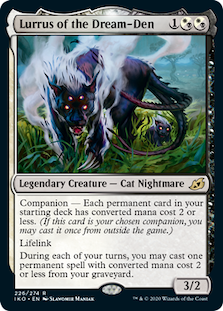 I genuinely think that Hammer is being propped up by 4-Color Omnath decks being Tier 1 and Lurrus of the Dream-Den as a companion. The first half is crucial because black removal is on the low ebb while red is riding high. As of writing, MTGTop8 says 39% of decks play Lightning Bolt and only 17.4% Fatal Push. Aid lets Hammer play around Bolt, but not Push, and Omnath is keeping black midrange down. It's also a very slow deck, so Hammer has the chance to get those fast wins.
I genuinely think that Hammer is being propped up by 4-Color Omnath decks being Tier 1 and Lurrus of the Dream-Den as a companion. The first half is crucial because black removal is on the low ebb while red is riding high. As of writing, MTGTop8 says 39% of decks play Lightning Bolt and only 17.4% Fatal Push. Aid lets Hammer play around Bolt, but not Push, and Omnath is keeping black midrange down. It's also a very slow deck, so Hammer has the chance to get those fast wins.
The second is because if anything goes wrong, Lurrus is the only saving grace. And it is Lurrus specifically, not Lurrus plus Mishra's Bauble. It's the only option to push through removal since there are so few real cards in Hammer Time. Smart opponents, given the option, will ignore every card but Hammer and Paladin. Lurrus is a plausible backup plan and is keeping Hammer Time viable. If anything happens to Lurrus or the metagame changes, I don't think Hammer Time can survive.
Death and Taxes
I know Death and Taxes well and felt that it was still a strong deck in the metagame despite losing ground. My testing confirmed that against the non-combo decks it was still a very strong choice. Most of the combo decks can push through Thalia, Guardian of Thraben pretty easily. Archon of Emeria is very strong, but Belcher can beat that too. DnT is fully 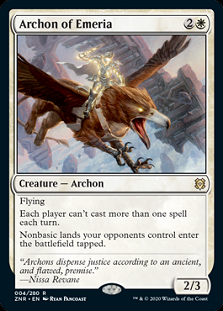 capable of beating combo decks (that's exactly what my Legacy version was doing all week), but to be good against the overall Modern metagame, I can't play all the anti-combo cards. They take too many sideboard slots and are too narrow in Modern's context. I was debating just pushing forward and hope to dodge combo after a few 4-1 results.
capable of beating combo decks (that's exactly what my Legacy version was doing all week), but to be good against the overall Modern metagame, I can't play all the anti-combo cards. They take too many sideboard slots and are too narrow in Modern's context. I was debating just pushing forward and hope to dodge combo after a few 4-1 results.
However, I also figured out why DnT had dropped off so much despite being a strong deck. DnT can grind through anything in the current meta (combo aside), but it's not easy. You have to maximize every mana, sequence properly, and know what to play around. This is especially true against Omnath, and while I think DnT is actually favored, it's not favored by much and can still lose easily. Which is how it goes with Legacy DnT, but right now Modern has so many decks with complete free-roll plays that I don't blame anyone trying for easier decks. With my eye back in on DnT, I took the opportunity to try something I actually wanted to play.
UW Spirits
I haven't played Spirits in over a year. Not because I thought it was bad, but because I don't have ~80% of the cards online. And like I've said many times, I don't want to put money into digital cards. However, I've theorized that it would be a very strong deck in the Uro-centric metagame before. From experience, I know that Spirits is very strong against slow decks. Spell Queller is superb against big spells, and Rattlechains lets you play around everything. Remorseful Cleric even gives Spirits maindeckable graveyard hate. With cost no longer being 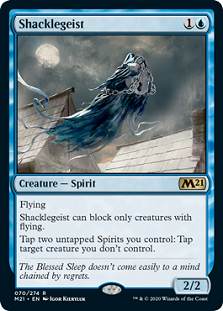 an issue, of course I was going to play Spirits. I didn't know how to build Spirits for the current metagame, so I just copied MTGO Trophy grinder and Spirits specialist DoctorQueller's list. I opted for Auriok Champion over the Burrenton Forge-Tender but made no other changes all week.
an issue, of course I was going to play Spirits. I didn't know how to build Spirits for the current metagame, so I just copied MTGO Trophy grinder and Spirits specialist DoctorQueller's list. I opted for Auriok Champion over the Burrenton Forge-Tender but made no other changes all week.
And I was rewarded with the only 5-0 of the week. Hooray me. I hold that Spirits is very well-positioned, and anyone looking for disruptive creatures would be amiss not to give it a try. However, I was wrong about why Spirits was good. Queller is too slow in a lot of matchups these days. Rather, the best card in the current metagame is Shacklegeist. Most of the top decks win with a single threat, often heavily boosted. Shacklegeist efficiently neutralizes those threats, and can be used offensively too. I hit a lot of Hammer Time and Scourge Shadow prior to the Super Qualifier and didn't drop a match thanks to Shacklegeist.
Bant Stoneblade
I have a soft spot for Bant decks. I love them and have all the cards. However, I never do well with them. They just don't work when I try them out. So when I saw that Bant Stoneblade was putting up numbers in early January, I was surprised. And when given the chance, I had to try it out. And it didn't go well. Worst results of any tested deck. It might have been my inexperience, or my matchups, but I struggled to win with Bant Stoneblade. The non-Uro threats were too underpowered relative to the meta, and there weren't enough hard answers for the control plan. At the same time, it felt like Uro wasn't supported enough, as though the deck was trying to be too many things. I was significantly disappointed.
Lessons of the Qualifier
Given that my best results was with Spirits, it was natural that I'd run it in the Super Qualifier. I've been dying for some real competitive Modern but again, won't shell out for cards online, so that wasn't an option until the All-Access passes. Humans had not been winning enough for me to try before then. And the tournament was massive: 431 players signed up for 10 rounds. Plus Top 8. For an event starting at 4 PM Mountain. That was up from the previoius Modern Super Qualifier's 375. This has actually led me to rethink how I allocate points for the metagame breakdown, but more on that next week.
The Tournament
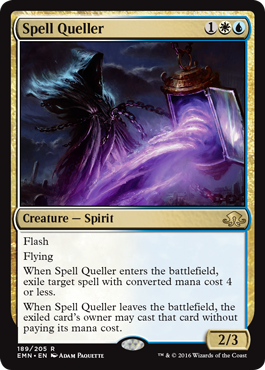 My tournament did not go well, and I dropped at 3-3. I knew that 7-3 could make prizes, but was out of Top 16 contention, which was not a deal-breaker. However, I also knew that my tiebreakers had to be terrible, because only the opponent from last round was still playing; assuming tiebreakers work on MTGO as they do in paper, I had to be at the very bottom of the 3-3's. This meant I would most likely be playing off-meta decks I wasn't prepared for, and since that's what I'd lost to, I didn't want to prolong my suffering.
My tournament did not go well, and I dropped at 3-3. I knew that 7-3 could make prizes, but was out of Top 16 contention, which was not a deal-breaker. However, I also knew that my tiebreakers had to be terrible, because only the opponent from last round was still playing; assuming tiebreakers work on MTGO as they do in paper, I had to be at the very bottom of the 3-3's. This meant I would most likely be playing off-meta decks I wasn't prepared for, and since that's what I'd lost to, I didn't want to prolong my suffering.
My rust definitely showed and I made a fair number of mistakes, though the play mistakes weren't enough to actually cost me games. What cost me were incorrect keeps in my last two losses. They were okay hands, but didn't work given what my opponent was doing in sideboard games, and I feel that I should have known that. However, again I am too rusty to make a definitive call there. However, despite doing poorly, I was so elated to be playing competitive Modern again that I really didn't care.
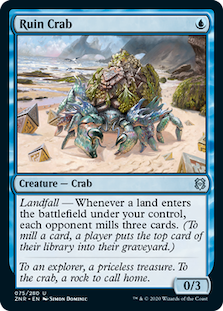 First round was a loss to 8-Crab Mill. In game 1, my opponent has three crabs on turn three, and that's not really raceable. Game 2 I'm 1 damage short, and I feel like I missed it somewhere. Alternatively, one more counterspell wins the game. Also, I was very annoyed because I'd been playing a single Gaea's Blessing in DnT for this very deck, but hadn't seen Mill in the Leagues and didn't bother with Spirits. Huge tilt there.
First round was a loss to 8-Crab Mill. In game 1, my opponent has three crabs on turn three, and that's not really raceable. Game 2 I'm 1 damage short, and I feel like I missed it somewhere. Alternatively, one more counterspell wins the game. Also, I was very annoyed because I'd been playing a single Gaea's Blessing in DnT for this very deck, but hadn't seen Mill in the Leagues and didn't bother with Spirits. Huge tilt there.
I then got three quick wins against Amulet Titan, the UW Spirits mirror, and Izzet Prowess thanks to Shacklegeist buying lots of turns in the races. The second loss was against Fires of Invention Taking Turns, which won thanks to drawing several Fires to get around my answers games 2 and 3. Then I lost to Grishoalbrand when game 1 saw two combo attempts stopped before Lightning Ax on Queller won the game. Game 2, an accelerated Through the Breach into Emrakul, the Aeons Torn wrapped things up. Spirits is very strong against the metagame decks, but struggles against anything off meta.
Updating Spirits
After the qualifier, I would not run back the same list I played. There were problems with casting my spells and the sideboard needs adjustment.
UW Spirits, Test Deck
Spirits always felt like it wanted 20.5 lands, not 20 or 21. Glasspool Mimic makes that a reality. I cut a Selfless Spirit and a Moorland Haunt to fit in two Mimics. Selfless was relevant the least, and the second Haunt is fairly superfluous. It also choked me on colored mana several times and nearly cost me games. I put the Selfless into the sideboard in place of an unneeded Cleric. Damping Sphere isn't so effective against the combo decks that actually see play right now, and big mana is also down, while Pithing Needle was a clean win against Belcher in Leagues will also being effective against a huge number of decks. I'd be much happier running this version of Spirits.
And So It Ends
It was nice getting the freedom to really explore the metagame we currently have right before it changes with Kaldheim incoming. Again, I think the shift will be small, but there's no way to know this earyl. We'll all see in a few weeks.


